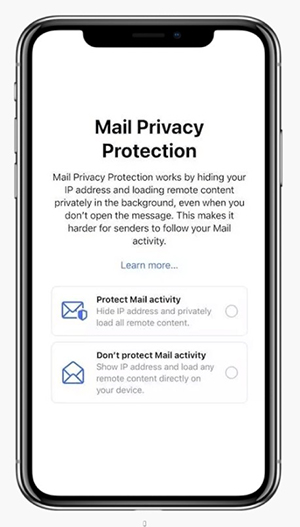Apple released its latest operating system for iPhones (iOS 15) and iPads (iPadOS 15) this past Monday, September 20th, 2021. The new OS comes on the heels of iOS/iPadOS 14.5, which hit the market earlier this year — and in similar fashion to that release, iOS 15/iPadOS 15 brings with it enhanced privacy options for users. Last time, the focus was on app tracking (which we blogged about). Now, the focus is on email privacy among other enhancements.
The specific update that’s focused on email is called Mail Privacy Protection. As Apple said in a recent news release:
Mail Privacy Protection … helps users prevent senders from knowing when they open an email,
and masks their IP address so it can’t be linked to other online activity or used to determine their location.
It’s important to note that in addition to iPhones and iPads, Mail Privacy Protection will also be an update that’s baked into the forthcoming macOS Monterey for Mac computers. The release is expected sometime this fall.
APPLE MAIL PRIVACY PROTECTION 101
As with just about every new release from Apple, iOS 15/iPadOS 15 has lots of cool new features for users. Again there are some visual changes, FaceTime enhancements, tools to help one “focus,” and so on. But it’s the evolution of privacy features — namely Mail Privacy Protection — that has us marketers stirring about.
From the user perspective, Mail Privacy Protection blocks senders from seeing your IP address and when you open a message. Instead, it routes your IP address through multiple proxy servers and randomly assigns you another IP address. For marketers, however, this means the ability to record and track open rates of email messages is pretty much out the window.
Mail Privacy Protection only applies to Apple email clients (i.e., the Mail app on the iPhone and iPad; and the Apple Mail app on Macs with macOS Monterey). It doesn’t matter which email service is used, whether it’s Gmail, Yahoo, and/or Exchange — if the user relies on the Apple client(s) for email, they have the option to apply Mail Privacy Protection. Other email clients/apps used on Apple devices, like the Gmail app, are not affected.
When applied, Mail Privacy Protection will allow the user to:
- Hide open email behavior by pre-loading email images, including tracking pixels
- Hide specific (e.g., city-level) location data by blocking IP addresses
- Obscure click-through activity by using a proxy email address

will see when they first launch the Mail app
on an iPhone after installing iOS 15.
When someone first opens the Apple Mail app, they’ll get a message prompting them to either “Protect Mail activity” or “Don’t protect Mail activity.” This will not be turned on by default; users will have to actively make a choice. But based on the 4% opt-in to ad tracking from Apple’s App Tracking Transparency tool (released with iOS 14.5) and the language around the Mail Privacy Protection options, it’s highly likely there will be similar opt-in rates for email tracking.
In other words, a significant number of opt-ins will likely be affected if or when they update their iPhones and iPads (and soon, Mac computers).
WHAT ARE THE EXPECTED IMPACTS?
Expected impacts include but are not limited to the following:
- An inflated Apple Mail open rate of around 75% (or otherwise inaccurately heightened)
- Audience segmentation or targeting based on the last open date would be rendered useless—especially critical for purging unengaged contacts
- Automated flows and journeys that rely on someone opening an email would need to get re-engineered
- A/B testing subject lines (or anything else) using opens to determine the winner or to automatically send out the winner won’t work anymore
- Send time optimization would become inaccurate
- Location tracking may no longer be reliable at the city and region/state level
- Revenue attribution may be inflated
ACTIONS THAT MARKETERS SHOULD TAKE RIGHT NOW
First and foremost, you should immediately assess how many of your email subscribers access their email through Apple email clients on iPhones, iPads, and Macs. Email marketing platforms such as Klaviyo, MailChimp, and Constant Contact all have audience reporting tools that make it easy to identify these numbers. Chances are pretty high that you will notice a change as users upgrade their iPhones, iPads, and Macs — because according to Litmus, 46.3% of all emails in 2020 were opened via Apple mail clients on the iPhone (34.2% of all email opens), Macs (10.4%), and iPads (1.7%).
To again help our clients navigate the constantly changing landscape, Tiny Bully prepared a quick-start guide – Apple Updates September 2021: Summary of Mail Privacy Protection and Expected Email Reporting Impacts – to not only provide an overview of what all of this means, but give marketers an actionable plan to address some of the expected impacts. Covered within are indicated actions including A/B testing, click optimization, reassessment of workflows, audience segmentation, and (most important!) relationship building.
So, grab our guide and get working on getting ahead of potential impacts. Let us know what you think!
